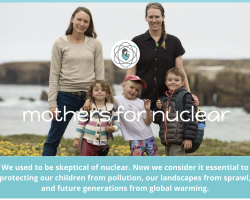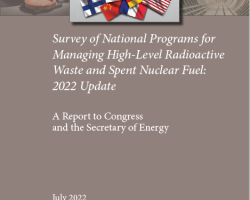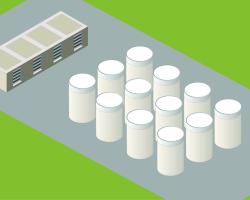Category of Content
Siting Experience Documents Only
Publication Date
Subject Matter
Keywords
Thermodynamic Database for Generic Disposal System Assessment
Thermodynamic Database for Generic Disposal System Assessment
Modeling Coupled THM Processes and Brine Migration in Salt at High Temperatures
Modeling Coupled THM Processes and Brine Migration in Salt at High Temperatures
Thermo-Hydrological and Chemical (THC) Modeling to Support Field Test Design
Thermo-Hydrological and Chemical (THC) Modeling to Support Field Test Design
Natural system evaluation FY11 year-end report
Natural system evaluation FY11 year-end report
Experimental and Modeling Investigation of Radionuclide Interaction and Transport in Representative Geologic Media
Experimental and Modeling Investigation of Radionuclide Interaction and Transport in Representative Geologic Media
Coupled Thermal-Hydrological-Mechanical Processes in Salt
Coupled Thermal-Hydrological-Mechanical Processes in Salt
Advances in 3D Geologic Modeling of Alluvial Basins with a Focus on Facies and Property Modeling
Advances in 3D Geologic Modeling of Alluvial Basins with a Focus on Facies and Property Modeling
Thermodynamic Properties of Brines, Minerals and Corrosion Products
Thermodynamic Properties of Brines, Minerals and Corrosion Products
Using Environmental Tracers to Estimate Fracture Network Properties
Using Environmental Tracers to Estimate Fracture Network Properties
THERMODYNAMIC DATABASE DEVELOPMENT, WITH EMPHASIS ON COMPLEX CLAY MINERALS
THERMODYNAMIC DATABASE DEVELOPMENT, WITH EMPHASIS ON COMPLEX CLAY MINERALS
THM Coupled Process Modeling with TOUGH-FLAC to Evaluate the Fate and Transport of Water in
THM Coupled Process Modeling with TOUGH-FLAC to Evaluate the Fate and Transport of Water in
LANL Activities in Model Benchmarking and Thermal Test Design Calculations
LANL Activities in Model Benchmarking and Thermal Test Design Calculations
Advanced Parameter Uncertainty Quantification Using Null Space Latin Hypercube Sampling: Application to Uranium and Neptunium Transport Experiments
Advanced Parameter Uncertainty Quantification Using Null Space Latin Hypercube Sampling: Application to Uranium and Neptunium Transport Experiments
DESIGNING A CONSENT-BASED SITING PROCESS: SUMMARY OF PUBLIC INPUT REPORT. Final Draft
DESIGNING A CONSENT-BASED SITING PROCESS: SUMMARY OF PUBLIC INPUT REPORT. Final Draft
Mothers for Nuclear Flyer
Mothers for Nuclear Flyer
Mothers for Nuclear Informational Flyer
Socio-technical multi-criteria evaluation of long-term spent nuclear fuel management strategies: A framework and method
Socio-technical multi-criteria evaluation of long-term spent nuclear fuel management strategies: A framework and method
In the absence of a federal geologic repository or consolidated, interim storage in the United States, commercial spent fuel will remain stranded at some 75 sites across the country. Currently, these include 18 “orphaned sites” where spent fuel has been left at decommissioned reactor sites.
Interim Storage, Environmental Justice, and Generational Equity
Interim Storage, Environmental Justice, and Generational Equity
With the termination of the Yucca Mountain project, which was proposed to be our nation’s first repository for the disposal of military and civilian spent nuclear fuel and high-level radioactive waste, the future of nuclear waste management and disposal in this country became increasingly uncertain. Interim storage has been advocated by many as a temporary solution while a permanent solution is studied for potentially several more decades to come.
Reset of America's Nuclear Waste Management Strategy and Policy
Reset of America's Nuclear Waste Management Strategy and Policy
The U.S. nuclear waste management program has labored for decades at a cost of billions of dollars each year, and yet there is still no active disposal program either for spent nuclear fuel from commercial reactors or for the high-level radioactive legacy waste and spent nuclear fuel from defense programs.
Interim Storage, Environmental Justice, and Generational Equity
Interim Storage, Environmental Justice, and Generational Equity
With the termination of the Yucca Mountain project, which was proposed to be our nation’s first repository for the disposal of military and civilian spent nuclear fuel and high-level radioactive waste, the future of nuclear waste management and disposal in this country became increasingly uncertain. Interim storage has been advocated by many as a temporary solution while a permanent solution is studied for potentially several more decades to come.
Environmental Risk Characterization Work Plan Yankee Nuclear Power Station Rowe, Massachusetts
Environmental Risk Characterization Work Plan Yankee Nuclear Power Station Rowe, Massachusetts
Communicating Risks and Benefits: An Evidence-Based User's Guide
Communicating Risks and Benefits: An Evidence-Based User's Guide
Effective risk communication is essential to the well-being of any organization and those people who depend on it. Ineffective communication can cost lives, money, and reputations. Communicating Risks and Benefits: An Evidence-Based User's Guide provides the scientific foundations for effective communication.
Survey of National Programs for Managing High-Level Radioactive Waste and Spent Nuclear Fuel: 2022 Update
Survey of National Programs for Managing High-Level Radioactive Waste and Spent Nuclear Fuel: 2022 Update
In October 2009, the U.S. Nuclear Waste Technical Review Board (Board or NWTRB) published Survey of National Programs for Managing High-Level Radioactive Waste and Spent Nuclear Fuel. For each of the 13 national programs studied, the report catalogued 15 institutional arrangements that had been set in place and 15 technical approaches that had been taken to design repository systems for the long-term management of high-activity radioactive waste.
Cost Implications of an Interim Storage Facility in the Waste Management System
Cost Implications of an Interim Storage Facility in the Waste Management System
This report provides an evaluation of the cost implications of incorporating a consolidated interim storage facility (ISF) into the waste management system (WMS). Specifically, the impacts of the timing of opening an ISF relative to opening a repository were analyzed to understand the potential effects on total system costs.



